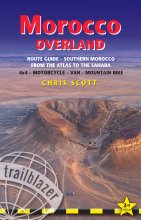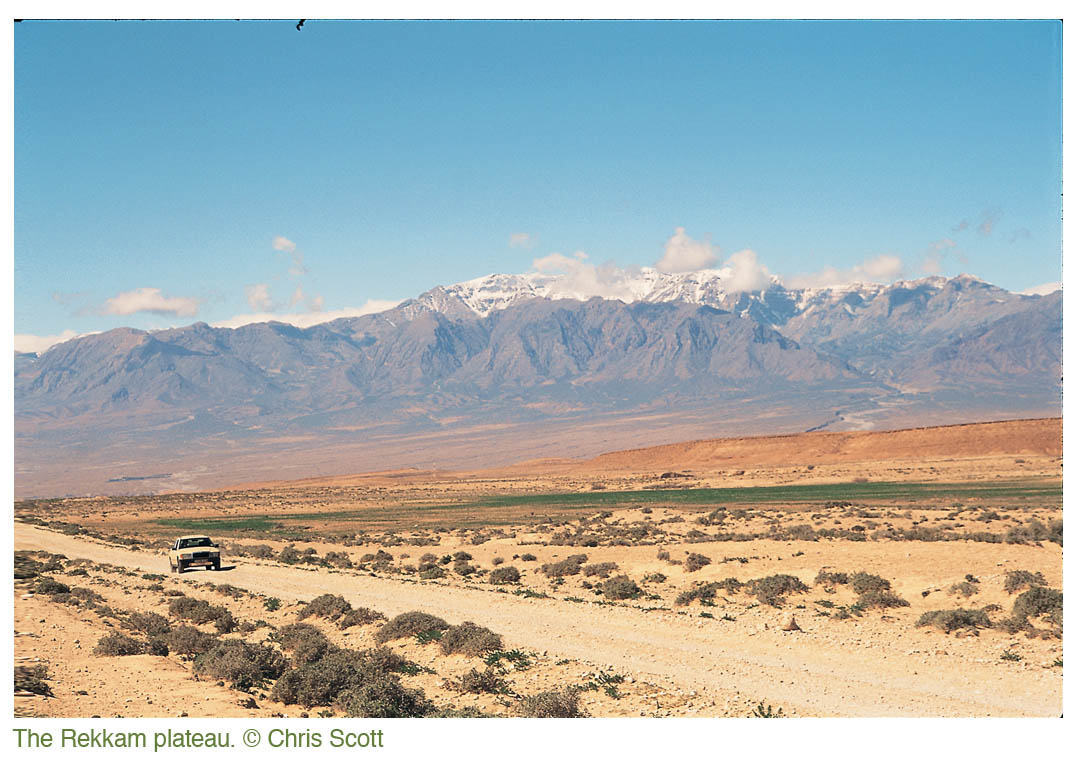'Fantastically detailed and well-presented.'
— Backpack magazine

Morocco Overland
Excerpt:
When to go
2CV Bike | Contents List | Introduction | When to go | Where to go | What can I do in...

WHEN TO GO
Morocco is a year-round destination but, depending on the season,
some regions will be more agreeable or accessible than others. The
short version is this: in summer the desert south of the Atlas will be
extremely hot, in winter tracks over the High Atlas may be snowed
over, and at any time of year heavy rain can render mountain tracks
impassable. Flooding or its consequent damage is the least pre-
dictable but most likely cause of inaccessible tracks and briefly
closed main roads in southern Morocco.
Some guidebooks suggest the spring thaw sees a high risk of
floods across the Atlas. It sounds plausible but anywhere in the
world, mountain snow melts steadily and there’s not that much of
it in Morocco anyway. A sustained period of heavy rainwill have a
much greater impact and this can happen at any time of year, but
most commonly in late summer into early autumn.
There’s not much you can do about flooding, but unless you
know better or are habituated to high temperatures, certainly on a
bike you’d do well to avoid Morocco in mid-summer, or at least
plan to stay in the mountains.
Climate patterns
Between them the influence of the Atlas mountains, the Sahara, the
Atlantic and the Mediterranean all complicate the Moroccan cli-
mate. The snow-bound summit of Jebel Toubkal (North Africa’s
highest mountain) is just 200km from the dunes of Chegaga and
many routes in this book can take you from 2500m (8000ft-plus)
passes down to the baking desert in a couple of hours. On one trip
in April I experienced scorching 40°C winds south of Foum Zguid
and met some bikers a few days later who were riding through
snow over the Rif Mountains at around the same time. In a car with
air-con, heating and wipers, the weather is not such a big deal, but
on a bike – with or without an engine – it certainly is.
North of the High Atlas the country experiences a predomi-
nantly Mediterranean climate of hot, dry summers and cool, wet
winters. Snowfall is likely in the Middle Atlas with winter rainfall
most prominent north of Casablanca and particularly in the Rif.
Heading south from the Mediterranean ports, from November to
March there’s a one-in-three chance you’ll get rain on any one day.
By the time you get to Marrakech it’s less than one-in-five and over the
Atlas in Ouarzazate the chances of getting wet are negligible. Ouarzazate is
Morocco’s driest and hottestbig town and can experience temperature varia-
tions of 58°C (though not necessarily in the same year) and an annual aver-
age rainfall of less than half an inch (< 12mm). Places further from the sea
and at lower elevation like Figuig or Zagora are drier and hotter still.
The wettest and coldest town is the alpine-style resort of Ifrane at 1665m/5463ft
in the Middle Atlas, with average daily lows barely above freezing from December
to March and with a lot of rain and snow from November to April. If you find
yourself heat struck in mid-summer Morocco, head for the cool cedar
forests of the Middle Atlas.
The desert wind
In the desert, winds are almost always present and when strong and from a
certain direction can reduce visibility to a few kilometres and render all land-
scapes hazy. The season begins in February with hot sand windsblowing for
days at a time. As the months progress and temperatures rise, summer skies
are often muddied by the heat-borne haze.
The term ‘sandstorm’ is often misused for conditions that are merely very
windy with some dust and sand blowing about; a pretty permanent situation
in the Sahara which occasionally escalates to the ‘sand wind’ described above.
Just like a regular thunderstorm, a true sandstorm is a relatively short and
intense event, lasting maybe a few hours. It will be associated with a wall of
sand coming at you and briefly engulfing you in zero visibility. A sprinkle of
rain often accompanies this dramatic event. Although, like thunderstorms,
they’re more common at the height or end of summer, in 30 years I’ve only
experienced this twice in the Sahara. One time was in May 2008 near
Merzouga when with little warning, a tsunami of sand hundreds of feet high
rolled towards us and wrapped the rocking car in a sandy fog.
In southern Morocco I find the most violent sand winds seem to come predominantly
from the south or south-east in the transient seasons of spring and
autumn, bringing with them the dust from the Western Sahara plateau. Such
a day can often end in rain which quickly rinses the skies, bringing a follow-
ing day of ragged clouds and clear air until the next front comes through.
The Atlantic influence
While the Atlantic coast of Morocco from Tan-Tan southwards sees the Sahara
unroll to its very shore, temperature extremes are mitigated by the ocean.
Places further north like Essaouira and particularly Agadir have the most
agreeable climates in Morocco, with moderate rainfall and temperatures all
helping make Agadir the country’s main beach resort. Down in the Western
Sahara, Laayoune recorded 44°C one day in June 2007, but generally the ocean
suppresses such extremes and summer temperatures here don’t usually
exceed the mid-30s. Dakhla (a special case, situated at the end of a peninsula)
never sees frost and gets temperatures above 30°C on no more than a couple
of days a year. At this time, however, right along the Atlantic Route strong
windsas well as cloud and fog are regular features.
AND WHEN NOT TO GO
Particularly on a motorbike or bicycle, avoid the Moroccan Saharabetween
June and September. At this time from Tangier southwards anywhere in
Morocco below 1500m can have a 40°C day and south of the Atlas these sorts
of temperatures occur daily for a month or two.
In winter expect to get rained onin the north as well as in the High- and
Middle Atlas ranges where snowis also a distinct possibility above 2000m.
However bad that might get, at this time at least you have the benefit of know-
ing that this book’s routes south of the High Atlas (ie: most of them) will prob-
ably experience near ideal conditions: clear skies but with little chance of get-
ting dangerously dehydrated while riding a bike.
In between these seasons – October to Novemberand February to March
– you have the greatest chance of exploring anywhere without getting com-
prehensively frozen, soaked or baked. Late autumn in particular can be a good
time with light winds, warm temperatures and clear skies.
Good weather websites covering Morocco include :www.weather
online.co.uk/Morocco.htm and :uk.weather.com/global (click ‘North
Africa’) which features sunrise and sunset times (see box on previous page).
Morocco Overland
Excerpts:
Price: £24.99 buy online now…
Latest tweets